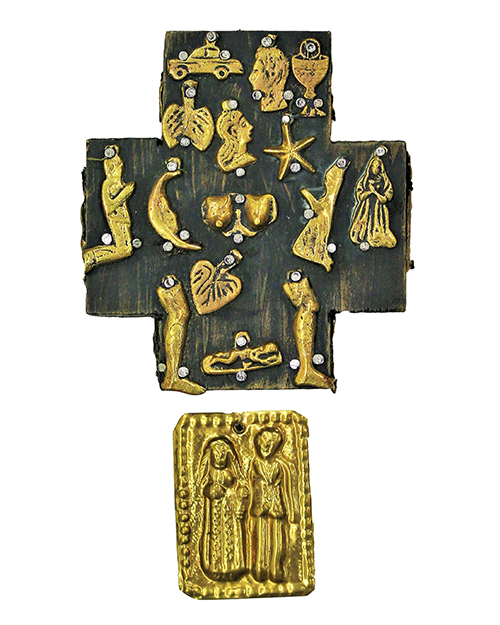Mexican Milagros

Small metal charms known as milagros are used throughout Latin America to symbolize prayers. They are pinned to crosses, statues of religious figures, and altars to petition for help and protection. They can also represent thanks for an answered prayer. Some people carry milagros with them for good luck, healing, or protection.
In Mexico, milagros are often used in gratitude as part of a manda or promise. When a person petitions a saint for a favor that is granted, that person must then go to the shrine of the saint and leave a milagro. Sometimes an additional thank you written on a small piece of paper is also left with the charm.
Milagros are a continuation of an ancient European practice of leaving symbolic offerings at shrines combined with similar votive practices in Indigenous Mexican cultures. Iberians, who lived in Spain between the fifth and first centuries BCE used bronze milagros that look remarkably similar to modern ones. The practice continued in the medieval Spanish Catholic Church, a tradition that the Conquistadors brought to the New World. For the Indigenous people, this practice resembled their rituals of offering gifts to the gods. As a result of this syncretism, the use of milagros spread across Latin America.
Milagros can be made of brass (as seen here), tin, alloys, or precious metals like silver or gold. In their most common form, they are mass produced by artists who stamp them from metal sheets or cast them in molds, creating the small, flat type of charm shown here. However, milagros can come in a range of sizes, and some are three-dimensional. Silversmiths also make custom charms for customers.
The form of a milagro is connected to the problem it aims to solve. However, there is no universal interpretation. They may take the shape of a person or body part to focus healing on a specific area. They can also appear in a wide variety of other forms including angels, animals, fruits, and vegetables. Some possible interpretations for the milagros on this cross include the following:
- Legs, breasts, lungs – healing of a specific injury or ailment in that part of the body. Legs can also represent the idea of a journey or travel
- Heart – healing a heart condition or for help with romance
- Praying people – symbolize devotion, prayers, or a specific saint
- Heads – easing worry, healing mental illness or headaches
- Car – requesting protection for safe travel
Today, milagros are often incorporated into folk art and jewelry in addition to being used for their original religious purpose.
To learn more about Christian religious practices, visit the virtual exhibit Faith: Five World Religions.

